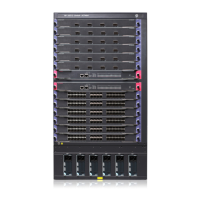324
[PE1-bgp] quit
# Configure CE 1, enabling VPNv4 capability and establishing VPNv4 neighbor relationship
between CE 1 and PE 1.
[CE1] bgp 200
[CE1-bgp] ipv4-family vpnv4
[CE1-bgp-af-vpnv4] peer 11.1.1.2 enable
# Allow the local AS number to appear in the AS-PATH attribute of the routes received.
[CE1-bgp-af-vpnv4] peer 11.1.1.2 allow-as-loop 2
# Disable route target based filtering of received VPNv4 routes.
[CE1-bgp-af-vpnv4] undo policy vpn-target
[CE1-bgp-af-vpnv4] quit
[CE1-bgp] quit
# Configure PE 2 and CE 2 in a similar way to configuring PE 1 and CE 1. (Details not shown.)
6. Establish MP-IBGP peer relationship between sub-VPN PEs and CEs of the customer VPN to
exchange VPNv4 routes of sub-VPNs:
# Configure PE 3.
[PE3] bgp 200
[PE3-bgp] peer 2.2.2.9 as-number 200
[PE3-bgp] peer 2.2.2.9 connect-interface loopback 0
[PE3-bgp] ipv4-family vpnv4
[PE3-bgp-af-vpnv4] peer 2.2.2.9 enable
# Allow the local AS number to appear in the AS-PATH attribute of the routes received.
[PE3-bgp-af-vpnv4] peer 2.2.2.9 allow-as-loop 2
[PE3-bgp-af-vpnv4] quit
[PE3-bgp] quit
# Configure CE 1.
[CE1] bgp 200
[CE1-bgp] peer 1.1.1.9 as-number 200
[CE1-bgp] peer 1.1.1.9 connect-interface loopback 0
[CE1-bgp] ipv4-family vpnv4
[CE1-bgp-af-vpnv4] peer 1.1.1.9 enable
[CE1-bgp-af-vpnv4] undo policy vpn-target
[CE1-bgp-af-vpnv4] quit
[CE1-bgp] quit
# Configure PE 4 and CE 2 in a similar way to configuring PE 3 and CE 1. (Details not shown.)
7. Verify the configurations:
# Execute the display ip routing-table command on PE 1 and PE 2 to verify that the public routing
tables contain only routes on the service provider network. Take PE 1 as an example.
[PE1] display ip routing-table
Routing Tables: Public
Destinations : 7 Routes : 7
Destination/Mask Proto Pre Cost NextHop Interface
3.3.3.9/32 Direct 0 0 127.0.0.1 InLoop0
4.4.4.9/32 ISIS 15 10 30.1.1.2 Vlan12

